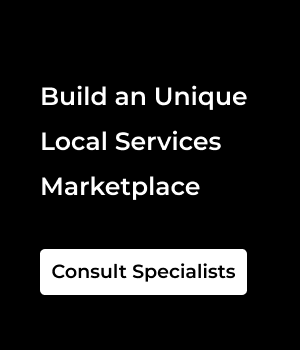Last Updated: October 05, 2023
Online service marketplaces help customers find service providers within their preferred regions for a vast variety of tasks, including carpentering, plumbing, electricity, cleaning, gardening, etc. Some of these marketplaces are TaskRabbit, Thumbtack and Handy that are aiming at connecting customers with professionals across a variety of verticals. The sheer popularity of the services marketplace business model has generated a lot of enthusiasm among entrepreneurs to enter this sector. This is why FATbit analysts did an elaborate review of key website features, business and revenue model that makes these platforms highly lucrative.
Before going through the website features, let’s take a look at the business model to get a better idea of market dynamics.
Table of Contents:
Business Model of Local Services Marketplace
The primary goal of local service marketplaces is connecting consumers with service professionals. Consumers can post their requirements on the platform in less than a minute and connect with professionals across categories to meet their specific requirements. Professionals can also highlight their skills by creating their profile, and get hired.
How do Local Services Marketplace Make Money?
Online marketplaces for local services incorporate various revenue streams for monetization. These include:
-
Service Commission: Platform owners can collect commission charges from service providers on the completion of each task.
-
Advertisements: These platforms can strategically infuse adverts across several of its pages in order to generate revenue.
-
Membership plans: Although registering on the platform is totally free, local services marketplaces can have membership plans with advanced features.
Essential Service Marketplace Features
One of the core aspects of a local services marketplace is that it has to be highly user engaging. While analyzing several websites like TaskRabbit, Thumbtack, Handy and Angi, we found that all of them had focused immensely on keeping their website quite easy to use and navigate. This clearly shows the level of consumer friendly approach required in this industry. Special emphasis needs to be put on ensuring that the website is highly intuitive and user engaging with advanced features. Let’s take a closer look at each one of these features:
Homepage
Homepage design can make or break the user experience. While some websites go all out putting every bit of information on the homepage, others tend to take a more subtle approach and keep the design minimum. When it comes to Local Services Marketplaces, one needs to take the latter approach and implement it perfectly. Some of the key areas of homepage include:
- A big banner image related to a particular service which randomly changes
- A navigation bar on the top that houses the logo, and links to important pages like signup/login, services, about us
- The banner image can have a search bar where users can search for services they require
Overall, the homepage needs to have a clean design, which is highly recommended to enhance the user experience.
Categories
As local service marketplaces cater to several services areas, the platform must have a dedicated section displaying all the categories. This makes it easy for the users to browse service professionals based on respective categories. We also recommend incorporating small thumbnail images along with category sections so that the users can easily identify the category.
How it works section for consumers
For every platform catering to a niche market, it is vital to convey its work process to the user base. This not only lets users get accustomed to the platform, but also increases the engagement rate. This is why that local service marketplace ought to have a dedicated section on its homepage, which tells the users how it works.
In addition to it, we also advise adding user reviews, which entices new users to buy the services. We emphasize greatly on this approach while designing a local service marketplace clone.
How it works section for professionals
In addition to consumers, the local service marketplaces also cater to the professionals who can easily find jobs on the platform. This is why it should have a section related to how the platform works for professionals. Similarly the website should incorporate a testimonial section where it displays what professionals say about the platform.
Cross Platform Availability
In the current age of mobility, having a mobile app has become a necessity for every online platform. Capitalizing on that aspect, your local services marketplace should have a dedicated mobile app. You should especially highlight its presence across all the devices preferably on the homepage.
Key Facts About The Platform
Users favor platforms with wider reach and presence. This is why your website should display a dedicated section on its homepage stating key figures. Using these facts, you can easily boast of your prominence in this niche market. FATbit analysts highly recommend this approach for local service marketplace clones.
Post your requirements section
This section asks users to post their requirement to start searching for qualified professionals. Users need to input their name, email, contact number, Category and location to get recommendations for their requirement.
Signup/login
Most platforms focus heavily on Signup page to make it easier for the users to create an account. When it comes to local service marketplaces, are based on a peer-to-peer platform catering to both professionals as well as consumers. This is why it needs to have multiple signup options in place. This means that a separate account is required for professionals and consumers. Let us look at consumer signup first.
Add requirements
After inputting account credentials, the marketplace can forward users to another page, where they have to post their requirement. This step, according to us, can be optional, as the users already have submitted most of the information on this form.
Want to upgrade UI/UX of your Website to Increase User Engagement
Additional Prerequisites
In order to help consumers and recommend ideal professionals, the website can add another step to the signup process. In this step, users have to tell some information about their pre-requisites which are then compared to the offering of the professionals for a better match. These include:
- Timeframe when the user wants the professional
- Days and timings of availability
- Additional details if any
In order to address the privacy aspect of the users, the website ought to take the consent of the users to share their contact details with the professionals. If the users want their privacy, they have the option to opt out of this.
My Profile
Under the profile section, users can edit and add their personal information like name, email, city and phone number. They also have the option to post a requirement directly from this page or ask a question if they have any query.
Help/FAQs Section
Before opting for any requirement, it is common among users to have certain queries. In order to address this, the website can have a dedicated section where users can post questions related to any category. Additionally they can also view top most FAQs asked frequently on the platform.
Billing History
To make it easy for the user to get all the details of payments, the website can make provision of a billing history section. It can show information like the date of payment, type of transaction and bill amount. Using this service, users can easily maintain all their bills in one place.
Referrals/Invite friends
One of the most beneficial features to expand the user base of an ecommerce website is via a referral program. Under this, users have an option to invite their friends over to the platform via email IDs or social networks.
Want to Start your Own Peer-To-Peer Marketplace
Search
Search is one of the most important features of any online marketplace. It is probably the fastest way to find relevant services. When it comes to the search experience of local service marketplace, there are points needed to be kept in mind:
- The search input should be divided into two aspects; location and category.
-
Features like autocomplete are highly recommended.
Professional Listing Page
The listing page of professionals needs to be designed to ensure that the users find relevant professionals in the least amount of time. Advanced filters help in that aspect, making it easy for the users to streamline the results as per their requirement. Some of the essential filters include:
- Service Area
- Keywords
- Gender
- Hourly rate
- Type of profile: Verified/Not-verified
Users can also have the option to sort the results based on relevance, experience, reviews and latest login. Each listing needs to be displayed with all the details like contact number, location, forte, number of years of experience as well as number of reviews.
Profile Page
This is one of the most vital aspects for any peer-to-peer marketplace. Taking cognizance of this fact, the website ought to put all the information related to the professional on this page in such a way that it does not hinder the user experience.
- The top section can display profile image, name, location, contact address and vital stats of the account.
- There can be different sections like profile, gallery reviews, answers and updates, which provides all the information to the users for making an informed decision.
-
Users can also have the option to write a review about the professional from this page.
- A related profile section can make it easy for the user to view additional profiles similar to the current professional.
Contact Professional
Users can easily communicate with professional using either their contact details or a messaging tool incorporated in the website.
Signup for Professionals
The process for creating a professional account is different as compared to a user account. Upon choosing the professional option during signup, users are forwarded to the different signup process meant for the professionals. Users have to input their name, email, password, contact number, location, and gender. Similar to the consumer signup, the process of account creation does not end here as there are additional steps involved in creating the account.
Services Offered
After adding the account credentials, professionals are asked to choose the categories related to their service areas. A nifty search bar can bring all the categories via autocomplete, making it easy to choose relevant categories. Professionals also have to add details about all the services they have selected. This includes location of each service and timing. Like consumers, professional should also have the option to opt out of sharing their contact details with others.
Premium Membership
In order to monetize the services, you can add option to upgrade to premium membership plans, which have additional benefits. Although registering on the platform can be free, in order to have additional features professionals need to buy premium membership.
Dashboard (Professional)
The dashboard for professional account needs to be focused around offering all the relevant information on a single page. This can include:
- Recent enquiries
- Profile views
- Background check
- Alerts
My Account (Professional)
This section can house all the details related to the transactions on their account as well as account settings. This includes billing history and other preferences.
Enquiries (Professional)
The enquiries section can display all the details related to the recent enquiries received by the professional. This makes it a vital hub for all the queries from consumers. Professionals can filter the enquiries based on New, Viewed and Contacted. Other options can include general enquiries, enquiry locations and recent calls received.
Some other Vital Points to Consider:
-
Single accounts for users and professionals: Earlier, a common practice among peer-to-peer marketplaces was to have separate accounts for each type of users. However, nowadays, it is more user-friendly to have a single signup option. This is why your local Service Marketplace can also opt in to have a single signup option rather than the one discussed by us earlier.
-
Lengthy registration process: In both the cases of registration, ensure that the process is minimal so that users do not feel account creation to be a hassle.
There is no denying that peer-to-peer marketplaces like Angi, TaskRabbit and Thumbtack have a huge demand. Localized service areas of these platforms leave a huge ground for new startups to mushroom. However, the real concern for startups is not the competition, but the features being offered. That is where the suggestions we have made throughout the post can come handy.
To ensure that your local service marketplace clone is able to capture the market, incorporate all the features described by us. Also, make sure that it is flexible enough to support upgrades and enhancements if required. Hire a professional team with ample expertise in UX design. If you need any help with website design and development, contact us any time for a consultation session.
Thinking of Launching a Local Service Marketplace?
FAQs
Q1: Is there any solution to build a local services marketplace?
Ans: There are numerous readymade solutions available in the market. You can have a look at our in-house solution, Yo!Gigs. It comes with all essential features to launch a powerful local services marketplace and is available at a one-time cost. As it is also fully customizable and scalable (comes with unlimited listings, transactions and user profiles), it is highly cost effective in the long run.
Q2: How to select local services marketplace software
Ans: While there’s no specific criteria to select a software, you might want to have a look over a few things to find the right software. These include the feature set, pricing structure and demo. You can also reach out to the sales experts to understand if the software would be able to match your business requirements.


